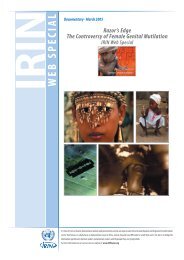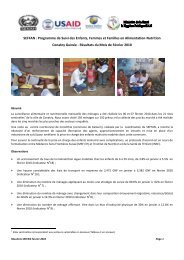Create successful ePaper yourself
Turn your PDF publications into a flip-book with our unique Google optimized e-Paper software.
century, governments have made numerous attempts to eradicate this<br />
“stain” from <strong>Rio</strong>’s landscape, including removal programmes and <strong>the</strong><br />
construction of housing projects on <strong>the</strong> city’s outskirts.<br />
As yet, however, no adequate solution has been found <strong>for</strong> <strong>Rio</strong>’s slum<br />
problem, or indeed that of o<strong>the</strong>r large Brazilian cities such as Sao Paulo,<br />
Belo Horizonte, Recife or Belem. By 2001, according to that year’s<br />
census, more than one million Brazilians were living in <strong>Rio</strong>’s cramped<br />
<strong>favelas</strong> – or about 20 percent of <strong>the</strong> population. 2<br />
‘comunas’ have suffered a similar process to <strong>Rio</strong>’s <strong>favelas</strong>, with <strong>the</strong><br />
problems associated with urbanisation bolstering <strong>the</strong> ranks of <strong>the</strong><br />
‘pandillo’ gangs, made up of disillusioned young men.<br />
In Africa, too, <strong>the</strong> impact of urbanisation on security levels has been<br />
dramatic. A recent police crackdown on gang activity in Nairobi,<br />
Kenya’s Mathare slum, in which at least 30 people were killed,<br />
underlined <strong>the</strong> problems <strong>the</strong> East African city is facing, many of which<br />
directly stem from issues of overcrowding and urbanisation.<br />
Overpopulation, <strong>the</strong> direct result of a 40-year trend of urbanisation and<br />
high birth rates, has caused an unprecedented social crisis affecting<br />
education, public health and public security.<br />
During <strong>the</strong> 1950s Brazil underwent a massive industrialisation drive<br />
under <strong>the</strong>n-president Juscelino Kubitschek. The rate of urbanisation<br />
rocketed, as thousands flocked from rural Brazil into <strong>the</strong> cities.<br />
According to <strong>the</strong> Brazilian Institute of Geography and Statistics (IBGE),<br />
Brazil was still a predominantly rural country until <strong>the</strong> 1960s. Since <strong>the</strong>n <strong>the</strong><br />
rate of urbanisation has climbed from 44.7 percent (1960) to 67.6 percent<br />
(1980). Between 1991 and 1996, more than<br />
12 million Brazilians moved from rural to<br />
urban Brazil. 3 According to <strong>the</strong> IBGE’s<br />
2000 census, over 80 percent of <strong>the</strong><br />
population now live in urban Brazil.<br />
The Brazilian sociologist and <strong>for</strong>mer <strong>Rio</strong><br />
security secretary Luiz Eduardo Soares<br />
traces a clear path between <strong>the</strong> process of urbanisation and <strong>the</strong> explosion<br />
of urban violence in Brazil’s sou<strong>the</strong>rn metropolises. “In less than two<br />
decades [1960-1980] a country that had 70% of its population in rural<br />
areas, transferred itself, en masse, to <strong>the</strong> cities in a chaotic way and in<br />
extreme conditions of deprivation, exploitation and poverty,” he writes. 4<br />
The result, Soares continues, was “social, economic, political and<br />
cultural crisis.”<br />
Across South America, perhaps most notably in Colombia, a similar<br />
situation is playing itself out. In Colombia thousands of displaced<br />
internal migrants – <strong>the</strong> ‘desplazados’ – and rural families have been<br />
<strong>for</strong>ced into slum dwellings, compounding <strong>the</strong> urban crisis. Colombia’s<br />
The search <strong>for</strong> a better life<br />
The story of Ricardo da Silva, originally from <strong>the</strong> impoverished<br />
nor<strong>the</strong>astern state of Pernambuco, is typical of this process.<br />
In Pernambuco, da Silva worked as a farm hand. In search of money, he<br />
came to <strong>Rio</strong> in 1992 and he found work in <strong>the</strong> Mundial supermarket<br />
chain. Like many o<strong>the</strong>rs he moved into a small concrete shack in <strong>the</strong><br />
Chatuba favela on <strong>the</strong> nor<strong>the</strong>rn outskirts of <strong>the</strong> city, <strong>the</strong> only af<strong>for</strong>dable<br />
accommodation he could find. In doing so he placed himself at <strong>the</strong><br />
sharp end of <strong>Rio</strong>’s problem with urban violence.<br />
The sheer scale and chaotic construction of <strong>the</strong> <strong>favelas</strong>, which became<br />
home to hundreds of thousands of migrants, made <strong>the</strong>m <strong>the</strong> ideal milieu<br />
<strong>for</strong> drug gangs to hide from <strong>the</strong> police and set up initially paternalistic,<br />
de-facto governments, albeit without any concrete political aims.<br />
Since <strong>the</strong> 1960s hundreds of thousands of Brazilians have made similar<br />
journeys south, to <strong>the</strong> peripheries of Sao Paulo and <strong>Rio</strong> de Janeiro. Today<br />
several bus companies offer special routes, which directly link small<br />
nor<strong>the</strong>astern towns to <strong>the</strong> <strong>favelas</strong> of <strong>Rio</strong>.<br />
The continued arrival of so many internal migrants can be explained by<br />
<strong>the</strong> desperate conditions in Brazil’s barren, drought-ravaged nor<strong>the</strong>ast.<br />
The Complexo do Alemao is one of <strong>the</strong> most deprived and<br />
underdeveloped corners of <strong>Rio</strong> de Janeiro.<br />
According to statistics put toge<strong>the</strong>r by <strong>Rio</strong>’s town hall, residents of <strong>the</strong><br />
shantytown live, on average, 13 years less than people born in <strong>the</strong><br />
58 r i o : f i g h t i n g f o r t h e f a v e l a s

















